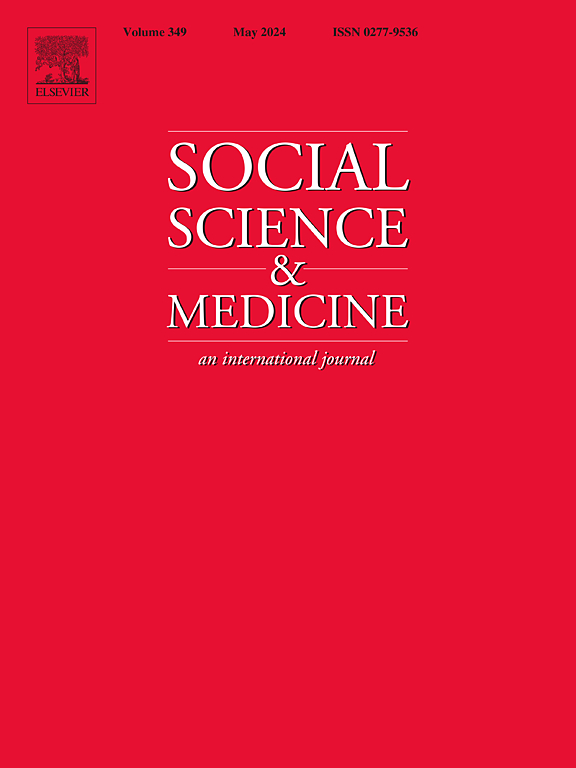Neighborhoods can be sexist too: Hostile sexism and risk of intimate partner violence across city neighborhoods
IF 5
2区 医学
Q1 PUBLIC, ENVIRONMENTAL & OCCUPATIONAL HEALTH
引用次数: 0
Abstract
Hostile sexism reflects prejudices and hostile attitudes toward women that may justify and facilitate intimate partner violence (IPV). The present study aimed to measure and map hostile sexism attitudes at the neighborhood level, and analyzed whether neighborhood-level hostile sexism was associated with the risk of IPV across city neighborhoods (Valencia, Spain). We used geocoded data on IPV cases (N = 2,060) aggregated at the census block group level (N = 552). Informed by a social disorganization theoretical framework, neighborhood-level covariates included administrative data on sociodemographic and contextual characteristics (i.e., income, immigrant concentration, residential instability, and social disorder and crime), and survey data on hostile sexism (N = 8,165). We conducted a small-area ecological study using Bayesian spatial modeling and disease mapping methods. Results showed the spatial clustering of neighborhood-level hostile sexism (i.e., these attitudes were not distributed equally across neighborhoods, but showed a distinctive geographical pattern), and that neighborhoods with higher levels of hostile sexism had higher relative risks of IPV, once other neighborhood-level characteristics were accounted for. This study showed that the unequal distribution of neighborhood-level hostile sexism compounded with other neighborhood characteristics (i.e., low income, high immigrant concentration, and high levels of social disorder and criminality) to explain important spatial inequalities in IPV risk across city neighborhoods. Neighborhood-level prevention efforts should consider including strategies to reduce gender biased social norms, prejudices, and hostile attitudes toward women that create a social climate that helps to justify, tolerate, and facilitate IPV.
社区也可能存在性别歧视:敌意的性别歧视和亲密伴侣暴力的风险遍布城市社区
敌对性别歧视反映了对妇女的偏见和敌对态度,这可能为亲密伴侣暴力(IPV)辩护和提供便利。本研究旨在测量和绘制社区层面的敌意性别歧视态度,并分析社区层面的敌意性别歧视是否与城市社区的IPV风险相关(Valencia,西班牙)。我们使用地理编码的IPV病例数据(N = 2060),在人口普查分组水平(N = 552)汇总。在社会无序理论框架的指导下,社区水平协变量包括社会人口统计学和背景特征(即收入、移民集中度、居住不稳定性、社会混乱和犯罪)的行政数据,以及敌意性别歧视的调查数据(N = 8,165)。我们利用贝叶斯空间建模和疾病制图方法进行了小区域生态研究。结果表明,敌意性别歧视的空间集聚性(即敌意性别歧视的态度在不同社区之间的分布并不均匀,而是呈现出独特的地理格局),在考虑其他社区特征的情况下,敌意性别歧视程度越高的社区发生IPV的相对风险越高。研究表明,社区层面敌意性别歧视的不平等分布与其他社区特征(即低收入、高移民集中度、高社会无序和高犯罪率)相结合,可以解释城市社区IPV风险的重要空间不平等。社区一级的预防工作应考虑包括减少性别偏见的社会规范、偏见和对妇女的敌对态度的战略,这些社会规范、偏见和态度创造了一种有助于证明、容忍和促进IPV的社会氛围。
本文章由计算机程序翻译,如有差异,请以英文原文为准。
求助全文
约1分钟内获得全文
求助全文
来源期刊

Social Science & Medicine
PUBLIC, ENVIRONMENTAL & OCCUPATIONAL HEALTH-
CiteScore
9.10
自引率
5.60%
发文量
762
审稿时长
38 days
期刊介绍:
Social Science & Medicine provides an international and interdisciplinary forum for the dissemination of social science research on health. We publish original research articles (both empirical and theoretical), reviews, position papers and commentaries on health issues, to inform current research, policy and practice in all areas of common interest to social scientists, health practitioners, and policy makers. The journal publishes material relevant to any aspect of health from a wide range of social science disciplines (anthropology, economics, epidemiology, geography, policy, psychology, and sociology), and material relevant to the social sciences from any of the professions concerned with physical and mental health, health care, clinical practice, and health policy and organization. We encourage material which is of general interest to an international readership.
 求助内容:
求助内容: 应助结果提醒方式:
应助结果提醒方式:


